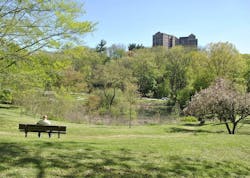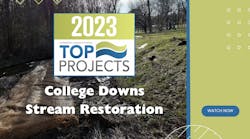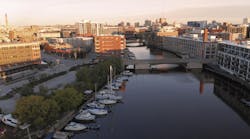Brian Rademaekers is public relations specialist for the Philadelphia Water Department. Rademaekers can be reached at [email protected]. Grace Maiorano is communications specialist for the Philadelphia Water Department. Maiorano can be reached at [email protected].
undefinedLike hundreds of communities across the U.S., Philadelphia is tasked with the monumental mission of significantly reducing combined sewer overflows that result during wet weather events.
While the need to address this problem is real, communities are grappling with a pollution source characterized as the last, toughest mile in an impressive marathon of clean water milestones that have seen urban waterways like the Delaware River return from the brink.
It is a journey that began with robust federal support and investment 40 years ago. The path is more complicated today, as the federal government’s share of capital spending in the water sector fell from 63% in 1977 to single-digit percentages of total capital spending in recent years. June 2021 marked a decade since the city of Philadelphia and its public utility, the Philadelphia Water Department (PWD), set out on a bold plan that aims to meet overflow volume reduction goals and more.
As an organization that is funded by ratepayers’ water bills and serves a city often referred to as “America’s poorest large city,” the utility knew that how they got to their regulatory goal mattered deeply to their communities.
Green City, Clean Waters, the plan approved by the Pennsylvania Department of Environmental Protection (PADEP) and the EPA in 2011-12, is well known in the world of water utilities as well as urban planners, sustainability advocates and environmental justice circles.
Yet, as Green City, Clean Waters notches its first decade, it is important to detail how success has been achieved so far and what it will take to move forward in a way that meets the needs of the city.
Perhaps the most important challenge has been not only introducing residents and stakeholders to a new way of doing and thinking about infrastructure but also building the broad support needed to sustain a neighborhood-based water quality plan over 25 years.
Today, the program is solidly supported by the people served. Building those types of connections and forging stronger partnerships with an ever-wider network of decision-makers will be critical in years 10 through 25.
“We remain dedicated to our vision: combining widespread, neighborhood-based green storm water infrastructure investment and targeted improvements to our robust sewer system to strategically reduce combined sewer overflows,” PWD Commissioner Randy E. Hayman, Esq. told the Greater Philadelphia Sustainable Business Network at the group’s Excellence in GSI Awards this spring. “The work will not get easier — it will get harder as we look for new ways to meet our goals. With commitment from our supporters and partners in both the private and public world, we can meet these challenges and succeed.”
Meeting Milestones
The agreement underpinning Green City, Clean Waters requires that a certain amount of “Greened Acres” be created every five years, with nearly 10,000 total by 2036. Greened acres represent areas where green storm water systems manage runoff rather than having impervious surfaces feeding into a combined sewer.
The department hit the mark for greened acres and other metrics in the first five years. Despite major COVID-19 pandemic hurdles, the department worked with its partners at the PADEP and will meet the 10-year goals by the end of 2021. This means the team anticipates 2,148 greened acres — a figure that has, so far, amounted to some 800 GSI sites with nearly 2,800 individual rain gardens, storm water trees, basins and other green systems. Zooming out, those systems represent an estimated 2.7-billion-gallon reduction in annual overflows as well as a major boost in community green spaces.
That is a roughly 21% improvement in yearly combined sewer overflow from when this started. Incremental improvements in overflow reduction, however, do not tell the whole story. The implementation of green storm water infrastructure through Green City, Clean Waters offers abundant opportunities to leverage the required investment in storm water management, improving neighborhoods across the city.
The co-benefits of green infrastructure are many, and include:
- Providing new green, open space;
- Preserving and restoring habitat;
- Advancing neighborhood livability and public health;
- Providing resilience to extreme weather and climate change;
- Creating a local, green economy;
- Supporting urban revitalization and;
- Increasing market values and attractiveness.
Community Roots
From the beginning, the city and PDW recognized the need to build community connections with Green City, Clean Waters. Their public engagement strategy has fostered stewardship of individual projects people live with but also ownership of the plan itself as a distinctly bold concept Philadelphians can embrace with civic pride.
“The advent of Green City, Clean Waters presented us with an opportunity to change the way we interacted with our residents,” said Glen Abrams, deputy commissioner of communications and engagement. “Most green storm water infrastructure systems are much more visible compared to traditional underground infrastructure. We wanted to make sure that people understood the need for this new type of infrastructure and had a voice in how the systems were planned and designed.”
A truly comprehensive community engagement program has been fine-tuned since 2011. This work informs and supports the planning and construction of green infrastructure projects throughout the city.
The team utilizes a multi-pronged strategy, relying on conventional practices, such as flyers, letters and holding community meetings that follow many projects from design to construction. There are also more creative methods, from murals paired with rain gardens to an interpretive green tools signage system.
Row Home Reservoirs
The focus of putting residents at the center of the plan resulted in programs that include Rain Check, designed to encourage homeowners to install landscape improvements that manage storm water, and Soak It Up Adoption, created to incentivize local organizations to provide supplemental maintenance and engage residents around local green storm water infrastructure.
Collectively these programs inspired nearly 13,000 individuals to beautify communities while helping to protect rivers and streams. Like other green infrastructure investments, they also fuel local environmental, economic and social benefits. This has built needed, solid support with the base of residential customers.
As documented in surveys conducted over the last six years, nearly half of customer survey respondents rank cleaning waterways as the second most critical issue that the water department should address. Only safe drinking water topped that priority.
Partnerships at Every Level
Every five-year milestone requires the department to reach more Greened Acres than the previous five years. This allows time for growth, but it also means an ever-increasing challenge: in the final 10 years, the department must create 60% of its Greened Acres.
The department works with fellow city agencies, including streets, public property, and parks and recreation departments, as well as vacant land managers and others, to incorporate the improvements.
Partnerships with public parties outside of city government, such as the Philadelphia School District, Philadelphia Housing Authority, public transit, PennDOT and local universities yield additional storm water management opportunities.
Using the Stormwater Grants program to incentivize projects with these groups and a range of private businesses and organizations is proving crucial to expanding the network of green storm water infrastructure and realizing lower-cost storm water management practices.
Lastly, storm water regulations requiring certain development projects to manage runoff on-site continue to be a huge driver bringing new Green City, Clean Waters projects to neighborhoods, adding environmental upsides to projects that protect rivers and streams.
All of these and more, including more active relationships with non-governmental organizations and coalitions like the Clean Waters Taskforce, representing leadership from more than 10 city agencies, need to grow and strengthen in the coming years, especially in light of growing regulatory demands and rising costs for all types of infrastructure.
The department is also looking at more ways to leverage Pennsylvania's revolving fund for water infrastructure, as it recently did for two projects that will help address overflows, one a large $6.7 million green package in Northeast Philadelphia and the other a $100 million wet weather facility upgrade.
“How we expand the base of partners who are truly invested in making this work will determine what the program looks like in the next five to 10 years,” said Marc Cammarata, PWD deputy water commissioner for Planning and Environmental Services. “We know what kind of infrastructure it takes to reach a certain volume reduction, but we have to ask ourselves if that is our only goal or if we are reaching for the kind of impacts the people we serve will really value at the end of the day.”






